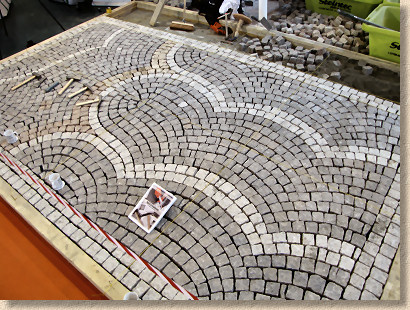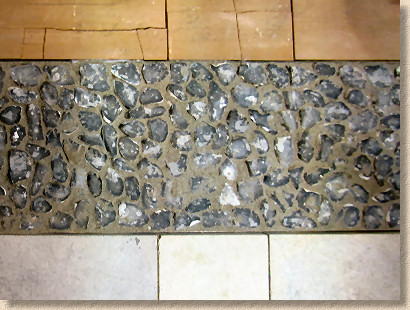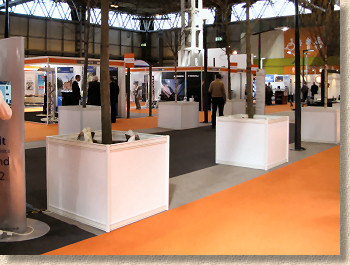StreetDesign 2011
StreetDesign 2011 , the biannual attempt to enthuse the streetscape and hard-landscaping industry, took place at Birmingham's NEC this week, co-located (as the organisers put it) with the much bigger Traffex and Parkex, which cater for the traffic management and vehicle parking industries relatively. In truth, StreetDesign is tacked on at one end, feeding almost parasitically off its larger host, attracting a small number of keen attendees but mostly relying on visitors to the larger events becoming lost or looking to fill up a spare 30 minutes before legging it to miss the rush hour traffic.
And, sad to say, 30 minutes would be just about long enough to trawl the sparse turnout of exhibitors. I managed to drag it out for 90 minutes, but that was largely due to the paucity of other visitors enabling me to spend longer than normal chatting to colleagues and acquaintances.
To be fair, anyone unfamiliar with the world of street-scaping could probably spend several hours trawling the stands, perusing the live demonstrations and listening in on the busy seminar schedule, but I'd adroitly managed to cock-up my diary and miss the best of the talks, which took place the day before my visit, and I've seen most of the demos at previous events.
I would really have liked to watch Pflasterer Meister Mario Johannes Tomasek show off his undeniable skills at the SteinTec stand. The completed sett panel tells it own story and shows what can be achieved when you put simple cubes of natural stone into the hands of a properly trained artisan. And that's what really struck me: Johannes has spent 8 years honing his skills to achieve the lofty status of “Engineer”, which entitles him to proudly display (and rightly so!) his status via his 'guild logo'. In his home country of Austria, and in many other European countries, the skills of a Pflasterer Meister, what we would call a street mason or mason paviour, are still highly valued and it's a trade that offers a respectable and lucrative career for anyone keen to work (hard) with their hands.

In Britain, we undertake virtually no training, and the result is eejits laying flags on spot bedding, or laying edge courses on sand backed up with a trowelful of twenty-to-plenty mortar, claiming that such methods are acceptable because they've been getting away with it for 20-odd years. The truly competent and skilled sett layers, flaggers, block layers and kerbers have no credible recognition of their expertise that can be used to differentiate them from the aforementioned eejits, and the whole trade is consequently devalued.

In the hope of inspiring a new generation of British and Irish streetmasons, Johannes can arrange training sessions for those keen to learn new skills or for experienced paviors looking to improve their existing knowledge. Further, SteinTec are importing seriously top quality mason's tools, such as splitting hammers and pitching chisels. These tools are not cheap, but they really will last you a lifetime and beyond.
Also new from SteinTec is an intriguing jointing and bedding material that simply defies conventional logic. The key ingredient of Tuffgrit® , as it is known, is crushed glass, but what makes it remarkable is that it contains no chemical binder (so no cement or resin) and it is self-healing. I know! How can a mortar repair itself? David Burton, MD at SteinTec obviously can't reveal all, but it's something to do with granule shape and size.
The same product is used as a bedding mortar and a jointing material. For bedding, it can be mixed to a suitable slump (semi-dry) and used in exactly the same way as a conventional mortar. For jointing, the mortar is brushed into the joints as a dry mix or a wet slurry, and is hardened by moisture. No stain, no residue, no efflorescence, no picture framing, allegedly. And if the pavement is accidentally over-loaded or subject to unexpected movement, as soon as the jointing is wetted, it will re-bind and reset!
Obviously, this is something that warrants further investigation, so anyone with 10-20m² of setts or cobbles to joint and willing to be used as a guinea pig should give me a shout as soon as possible.
Other hot news from the show comes from another long-time champion of the stone industry, Michael Heap, MD at CED , one of the nation's largest suppliers of natural stone. In what can only be regarded as a real coup for the British Stone trade, he's managed to persuade the British Geological Survey to use a fabulous selection of native stone to pave their new HQ in the East Midlands. The original plan had proposed to use a small percentage of native stone, supplemented with concrete on the grounds of cost. However, with a bit of canny negotiating, and (I suspect) a measured dose of arm twisting, Michael has persuaded a whole slew of British and Irish quarries to provide stone at a one-size-fits-all fixed price.
So, granite from Mourne, Old Red Sandstone from Dumfriesshire, Welsh and Cornish Slate, Yorkstone from both sides of the Pennines, and even flints from southern England are all being supplied at the same rate, and will be used to pave a geological timeline, stretching from the Pre-Cambrian ( >500 million years ago) represented by a superb Anorthosite from the Hebrides, through the Silurian (c.430 Mya), the Carboniferous (c.330 Mya), the Jurassic (c.175 Mya) and right up to relatively modern Neogene alluvial and glacial deposits which will be represented by gravels and boulders.

Visitors to the BGS's new headquarters will literally travel through time as they proceed along an avenue of native stones, and work is due to start in just a couple of months. This is no small project: there are several hundred square metres of paving, laid out chronologically, but in carefully designed offset panels to stimulate interest and comparison.
Michael is justifiably enthused and excited about this project. He's put in a lot of work, not just persuading the various quarries to play ball with pricing, but in finding the right combination of stone from each geological period to ensure every example is shown off to its best, providing contrast between colour, texture and finish.
At a time when more and more of our town and city centres are being re-surfaced with genuine value-for-money stone from Asia and beyond, this should serve as a timely reminder that we have fascinating stone in our own backyard. Maybe we can't compete on price, but there should be room for some native stone on every project, even if it's only as a contrast edging or detail feature. Our native stone is what gave local character to homes, to market squares, to civic buildings, and it's a little bit of our heritage that deserves to be cherished and respected.

Other than that, it was a fairly lacklustre affair. It's not fair to pin any of the blame on the exhibitors: they can only show their wares to whoever turns up, and that seems to be the crux of the problem. Footfall was underwhelming, to put it mildly, so no matter how much effort the likes of HardScape or Instarmac put into their presentations, it seems a combination of a troubled economy, public sector cutbacks, a battered construction industry and underachieving publicity have led to the subdued atmosphere that pervaded the whole event, Traffex and Parkex included.
Had it not been for the genuinely exciting news from SteinTec and CED, this would have gone down as an unforgivable waste of a day and half-a-tank of diesel. This will obviously colour the decision on whether to attend the 2013 event, assuming there will be a 2013 event. StreetDesign is just about the only viable exhibition directly targeting the trade, but it needs an injection of a big name and/or a new approach to widening its audience to bring in more designers, specifiers and contractors.


